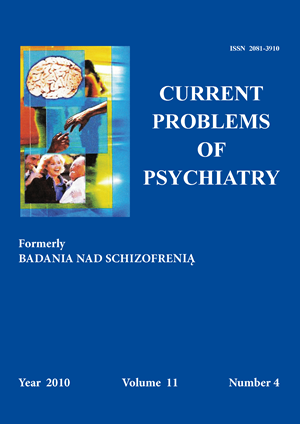Tlenek azotu (NO) wszechstronny regulator procesów życiowych.Rola w patomechanizmie uzależnienia od alkoholu i przebiegu zespołu abstynencyjnego
Słowa kluczowe:
tlenek azotu, mechanizmy działania NO, uzależnienie od alkoholu, zespół abstynencyjnyAbstrakt
Wprowadzenie i cel: Celem pracy była analiza dostępnej literatury pod kątem poznania funkcji i mechanizmów działania endo- i egzogennego tlenku azotu (NO). Szczególną uwagę zwrócono na zaangażowanie donorów tlenku azotu w patomechanizmie uzależnienia od alkoholu i przebiegu zespołu abstynencyjnego.
Wyniki i dyskusja: Tlenek azotu (NO) został odkryty jako związek chemiczny w 1770 roku. Od tej pory powstało wiele prac nad biochemią NO. W 1998 roku Nagrodę Nobla w dziedzinie medycyny za prace nad ciągiem przemian metabolicznych: L-arginina → NO otrzymali: Robert F. Furchgott, Louis Ignarro i Ferid Murad. Istnieją rożne mechanizmy prowadzące do aktywacji poszczególnych izoform NOS i w rezultacie do syntezy NO. Również NO powstały w reakcji katalizowanej przez różne NOS, spełnia w organizmie rożne funkcje. Nadprodukcja endogennego NO bierze udział w patogenezie wielu chorób m.in. innymi: miażdżycy, chorób zwyrodnieniowych układu nerwowego, zapaleń, chorób autoimmunologicznych i raka. Niedoborowi endogennego NO przypisuje się m.in. powstawanie nadciśnienia, w przebiegu preeclampsji, artherosclerozy, hipercholesterolemii. Pacjentom podaje się egzogenny NO, co poprawia stan chorych z miażdżycą żył kończyn dolnych, z chorobą wieńcową, z nadciśnieniem indukowanym ciążą. Zwiększenie lub niewielkie zmniejszenie syntezy tlenku azotu w ciągu pierwszych 4 tygodni abstynencji może być czynnikiem prognostycznym przerwania abstynencji w ciągu kolejnych 5 miesięcy.
Bibliografia
1. Maleck W.H., Piper S.N., Koetter K. Joseph Priestley, nitrous oxide and oxygen. Anaesthesist, 2005; 54: 395-396.
2. Sternbach G.L., Varon J. The discovery and rediscovery of oxygen. J Emerg Med. 2005; 28: 221-4.
3. Severinghaus J.W. Fireair and dephlogistication. Revisionisms of oxygen’s discovery. Adv. Exp. Med. Biol., 2003; 543: 7-19.
4. Marsh N., Marsh A. A short history of nitroglycerine and nitric oxide in pharmacology and physiology. Clin. Exp. Pharmacol. Physiol., 2000; 27: 313-319.
5. Katsuki S., Arnold W., Mittal C., Murand F. Stimulation of guanylate cyclase by sodium nitroprusside, nitroglycerin and nitric oxide in various tissue preparations and comparison to the effects of sodium azine and hydroxylamine. Cyclic Nucleotide Res., 1977; 3: 23-35.
6. De Berrazueta J.R. The Nobel Prize for nitric oxide. The unjust exclusion of dr. Salvador Moncada. Rev. Esp. Cardiol., 1999; 52: 221-226.
7. Furchgott R.F. Endothelium-derived relaxing factor: discovery, early studies, and identification as nitric oxide. Biosci. Rep., 1999; 19: 235-251.
8. Ignarro L.J., Buga G.M., Wood K.S., Byrns R.E., Chaudhuri G. Endothelium derived relaxing factor produced and released from artery and vein is nitric oxide. Proc. Nat. Acad. Sci. USA, 1987; 84: 9265-9269.
9. Poderoso J.J. Nobel Prize in medicine 1998: resurrection of an inorganic gas into a molecule of high biological significance. Medicina, 1999; 59: 205-207.
10. Moncada S., Higgs A. Mechanism of disease: L-arginine-nitric oxide pathway. N. Engl. J. Med., 1994; 329: 2002-2012.
11. Garthwaite G., Batchelor A.M., Goodwin D.A., Hewson A.K., Leerning K., Ahmed Z., Cuzner M.L., Garthwaite J. Pathological implications of iNOS expression in central white matter: an ex vivo study of optic nerves from rats with experimental allergic encephalomyelitis. Eur. J. Neurosci., 2005; 21: 2127-2135.
12. Rytlewski K., Zdebski Z. Nitric oxide - one of the mechanisms that prevent changes that occur during pregnancy. Gin. Pol., 2001; 72: 738-743.
13. Korbut R., Trabka-Janik E., Gryglewski R.J. Cytoprotection of human polymorphonuclear leukocytes by stimulators of adenylate and guanylate cyclases. Eur. J. Pharmacol., 1989; 165: 171-172.
14. Hecker M., Mitchell J.A., Swierkosz T.A., Sessa W.C., Vane JR Inhibition of l-glutamine fo the relears of endo-thelium-derived relaxing factor from cultured endothelial cells. Br. J. Pharmacol., 1990; 101: 237-239.
15. Francisco Y.A., Dantas A.P., Carvalho M.H., Laurindo F.R. Estrogen enhances vasoconstrictive remodeling after injury in male rabbits. Braz. J. Med. Biol. Res., 2005; 38: 1325-1329.
16. Geller D.A., Lowenstein C.J., Shapiro R.A., Nussler A.K., Di Silvio M., Wang S.C., Nakayama D.K., Simmons R.L., Snyder S.H., Billiar T.R. Molecular cloning and expression of inducible nitric oxide synthase from human hepatocytes. Proc. Natl. Acad. Sci. USA, 1993; 90: 3491-3495.
17. Seidel M., Kurpisz M. Endoteilalna syntaza tlenku azotu CZ. I. Struktura genu i produktu białkowego. Post. Biol. Kom., 2004; 31: 465-447.
18. Shin C.Y., Choi J.W., Ryu J.R., Ko K.H., Choi J.J., Kim H.S., Lee J.C., Lee S.J., Kim H.C., Kim W.K. Glucose deprivation decreases nitric oxide production via NADPH depletion in immunostimulated rat primary ast-rocytes. Glia., 2002; 37: 268-274.
19. Gauthier K.M., Zhang D.X., Ewards E.M., Holmes B., Campbell W.B. Angiotensin II dilates bovine adrenal cortical arterioles: role of endothelial nitric oxide. Endocriniolgy, 2005; 146: 3319-3324.
20. Broillet M.C. S-nitrosylation of proteins. Cell. Mol. Life Sci., 1999; 55: 1036-1042.
21. Aricioglu F., Paul I.A., Regunathan S. Agmatine reduces only peripheral-related behavioral signs, not the central signs, of morphine withdrawal in nNOS deficient transgenic mice. Neurosci. Lett., 2004; 354: 153-157. 22. Klamer D., Palsson E., Revesz A., Engel J.A., Svensson L. Habituation of acoustic startle is disrupted by psychotomimetic drugs: differential dependence on dopaminergic and nitric oxide modulatory mechanisms. Psychopharmacology, 2004.
23. Budzyński J., Kłopocka M., Świątkowski M., Ziółkowski M., Pulkowski G., Kopczyńska E. Nitric oxide metabolites plasma level in alcohol dependent male patients during six-month abstinence. Alkoholizm i Narkomania, 2004; 17: 197-209.
24. Budzyński J., Kłopocka M., Świątkowski M., Ziółkowski M., Pulkowski G., Kopczyńska E. Can an increase of nitric oxide metabolites concentration after first four weeks of abstinence predict alcohol relapse during the next five months? Alkoholizm i Narkomania, 2004; 17: 211-220.


